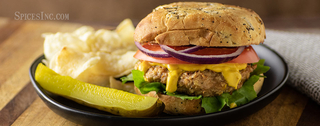Granulated Green Bell Pepper




Granulated Green Bell Pepper
Granulated Green Bell Peppers, Capsicum annuum, measure 0 Scoville Heat Units (SHU). Granulated Green Bell Peppers are also referred to as green pepper seasoning, granulated pepper, or green bell pepper granulated.
Granulated Green Bell Peppers have been picked before they are ripened, preserving their sharp, grassy flavor. They are then dehydrated and ground. Bell peppers are members of the Solanaceae family, which also includes eggplant, potatoes and tomatoes.
Granulated Green Bell Peppers are commonly purchased by:
- seasoning companies;
- butchers; and
- condiment, meal kit, meat processing, snack food, and frozen pizza manufacturers
We also have diced Dried Green Bell Peppers, Diced Red Bell Peppers, and Granulated Red Bell Peppers available.
Flavor Profile
Granulated Green Bell Peppers have a grassy, brisk flavor and bittersweet finish.
Heat Level
Dried Green Bell Peppers are completely mild and have a rating of 0 Scoville Heat Units.
How To Use
Granulated Green Bell Peppers are small and rehydrate easily; simply add them to a dish and allow the natural moisture in the dish to rehydrate the peppers as you cook. This is a wonderful addition to a mild queso dip and is delicious in marinaras, dressings, and marinades. Toss into stir fry or mix into ground beef for flavorful burgers and meat loaf. Gives potato salad an extra boost of color and texture.
Pair Granulated Green Bell Peppers with onion, garlic, coriander, cilantro, thyme, parsley, black beans, cheese, chickpeas, eggplant, eggs, potatoes, and tomato.
Use Granulated Green Bell Peppers when making omelets, chicken, beef, pork, or tofu stir fry, tomato sauce, pizza, pasta, potatoes, chili, soup, stew, dips, potatoes, cream sauces, and cheese products.
| Also Called | Green pepper seasoning, granulated pepper, or green bell pepper granulated |
| Species | Capsicum annuum |
| Ingredients | Granulated, dehydrated green bell pepper |
| Flavor Profile | Grassy, tangy, brisk |
| Scoville Heat Units | 0 SHU |
| Recommended Uses | Soups, dips, chilis, ground meat, stir fry, potatoes |
| Cuisine | Global |
| How To Store | Airtight container in a cool, dark place |
| Shelf Life | 6-12 months |
| Country of Origin | China |
Nutrition Facts
Serving Size1 tsp
Amount Per Serving
Calories10
% Daily Value*
Total Fat0g0%
Saturated Fat0g0%
Trans Fat0g
Polyunsaturated Fat0g
Monounsaturated Fat0g
Cholesterol0mg0%
Sodium5.3mg0%
Total Carbohydrate1.9g1%
Dietary Fiber0.6g2%
Total Sugars1.1g
Added Sugars0g0%
Sugar Alcohol0.0g
Protein0.5g1%
Vitamin D0mcg0%
Calcium4mg0%
Iron0mg2%
Potassium86mg2%
*The % Daily Value (DV) tells you how much a nutrient in a serving of food contributes to a daily diet. 2,000 calories a day is used for general nutrition advice. These values were calculated and therefore are approximate. For more accuracy, testing is advised.




